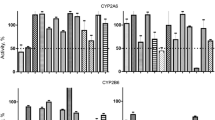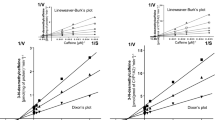Abstract
Tilidine exhibits the highest consumption of opioids in Germany. The prodrug is hepatically metabolised in a sequential N-demethylation reaction. Its primary metabolite nortilidine is a selective μ-opioid receptor agonist which can penetrate the blood–brain barrier. Cytochrome P450 isozymes (CYP) 3A4 and CYP2C19 were previously identified as isozymes mediating the formation of nortilidine. This study was set up to identify the enzymes and kinetics of the subsequent N-demethylation to bisnortilidine, thus being able to understand clinical interactions. Human liver microsomes and recombinant CYPs were used to investigate the metabolism of nortilidine to bisnortilidine. Nortilidine and bisnortilidine were quantified using liquid chromatography tandem mass spectrometry. Inhibitor screening kits were used to quantify the inhibition of CYP3A4, CYP2C19, CYP2B6 and CYP2D6 by bisnortilidine. Nortilidine metabolism to bisnortilidine followed the Michaelis–Menten kinetics with K m = 141.6 ± 15 μM and V max = 46.2 ± 3 nmol/mg/h. Inhibitors of CYP3A4, CYP2C19 and CYP2B6 inhibited this reaction. Assays with recombinant CYPs verified that the N-demethylation is catalysed by CYP3A4, CYP2C19 and CYP2B6. Our results also demonstrated that the metabolism from tilidine to nortilidine is not only mediated by CYP3A4 and CYP2C19, but also by CYP2B6. Moreover, bisnortilidine is a weak inhibitor of CYP3A4 and CYP2B6, a strong inhibitor of CYP2D6, but not an inhibitor of CYP2C19. Our study demonstrated that nortilidine is metabolised via the same CYP isozymes as the prodrug tilidine, whereas the formation of bisnortilidine appears to be the rate-limiting step in the metabolism of tilidine. Pharmacokinetic interactions can be expected with inhibitors or inducers of CYP3A4, CYP2C19 or CYP2B6.



Similar content being viewed by others
References
Grün B, Krautter S, Riedel K-D, Mikus G (2009) Inhibition of the active principle of the weak opioid tilidine by the triazole antifungal voriconazole. Br J Clin Pharmacol 68:712–720
Hajda JP, Jahnchen E, Oie S, Trenk D (2002) Sequential first-pass metabolism of nortilidine: the active metabolite of the synthetic opioid drug tilidine. J Clin Pharmacol 42:1257–1261
Hesse LM, von Moltke LL, Shader RI, Greenblatt DJ (2001) Ritonavir, efavirenz, and nelfinavir inhibit CYP2B6 activity in vitro: potential drug interactions with bupropion. Drug Metab Dispos 29:100–102
International Narcotics Board Control (INCB) (2011) Estimated world requirements of narcotic drugs in grams for 2011. http://www.incb.org/pdf/e/estim/2011/EstFeb11.pdf. Accessed 05 Feb 2011
Obach RS (1997) Nonspecific binding to microsomes: impact on scale-up of in vitro intrinsic clearance to hepatic clearance as assessed through examination of warfarin, imipramine, and propranolol. Drug Metab Dispos 25:1359–1369
Obach RS (2000) Metabolism of ezlopitant, a nonpeptidic substance P receptor antagonist, in liver microsomes: enzyme kinetics, cytochrome P450 isoform identity, and in vitro-in vivo correlation. Drug Metab Dispos 28:1069–1076
Pfizer (2011) Fachinformation Valoron® N retard. http://www.fachinfo.de/data/fi/jsearch/viewPDF?praep&1716797840. Accessed 10 Jan 2012
Schulz R, Blasig J, Wuster M, Herz A (1978) The opiate-like action of tilidine is mediated by metabolites. Naunyn Schmiedebergs Arch Pharmacol 304:89–93
Shah VP, Midha KK, Dighe S, McGilveray IJ, Skelly JP, Yacobi A, Layloff T, Viswanathan CT, Cook CE, McDowall RD et al (1991) Analytical methods validation: bioavailability, bioequivalence and pharmacokinetic studies. Conference report. Eur J Drug Metab Pharmacokinet 16:249–255
Shimada T, Yamazaki H, Mimura M, Inui Y, Guengerich FP (1994) Interindividual variations in human liver cytochrome P-450 enzymes involved in the oxidation of drugs, carcinogens and toxic chemicals: studies with liver microsomes of 30 Japanese and 30 Caucasians. J Pharmacol Exp Ther 270:414–423
Thierry C, Boeynaems JM, Paolo M (2005) Actions of tilidine and nortilidine on cloned opioid receptors. Eur J Pharmacol 506:205–208
Trojan A, Beil HW (1978) Tilidine abuse and dependence. Drug Alcohol Depend 3:383–391
Trojan A, Beil H, Berger H, Daunderer M, Heckmann G, Hieber-Landvogt E, Kellermann B, Sollner H (1979) On the problem of “primary” addiction to tilidine (Valoron and Valoron N) (author’s transl). Offentl Gesundheitswes 41:864–870
Vollmer KO (1988) Pharmacokinetic aspects of the Valoron-N principle. Balanced pharmacokinetics of nortilidine and naloxone. Fortschr Med 106:593–596
Vollmer KO, Hodenberg AV (1977) Metabolism of -trans-2-dimethylamino-1-phenyl-cyclohex-3-ene-trans-1-carboxylic acid ester hydrochloride (tilidine HCl). 3. Renal elimination of metabolites in the rat, dog and man. Arzneimittelforschung 27:1707–1713
Vollmer KO, Poisson A (1976) On the metabolism of ethyl-DL-trans-2-dimethylamino-1-phenyl-cyclohex-3-ene-trans-1-carboxylate-hydrochloride (tilidine-HCl). 2nd communication: studies with 14C-labelled substance on rats and dogs. Arzneimittelforschung 26:1827–1836
Vollmer KO, Thomann P, Hengy H (1989) Pharmacokinetics of tilidine and metabolites in man. Arzneimittelforschung 39:1283–1288
Weiss J, Sawa E, Riedel K-D, Haefeli WE, Mikus G (2008) In vitro metabolism of the opioid tilidine and interaction of tilidine and nortilidine with CYP3A4, CYP2C19, and CYP2D6. Naunyn Schmiedebergs Arch Pharmacol 378:275–282
Zhang W, Ramamoorthy Y, Kilicarslan T, Nolte H, Tyndale RF, Sellers EM (2002) Inhibition of cytochromes P450 by antifungal imidazole derivatives. Drug Metab Dispos 30:314–318
Acknowledgements
We thank Magdalena Longo, Monika Maurer, Andrea Deschlmayr and Jutta Kocher for their excellent technical help, and Pfizer for their kind gift of tilidine and nortilidine.
Author information
Authors and Affiliations
Corresponding author
Rights and permissions
About this article
Cite this article
Wustrow, I., Riedel, KD., Mikus, G. et al. In vitro identification of the cytochrome P450 isozymes involved in the N-demethylation of the active opioid metabolite nortilidine to bisnortilidine. Naunyn-Schmiedeberg's Arch Pharmacol 385, 633–639 (2012). https://doi.org/10.1007/s00210-012-0737-z
Received:
Accepted:
Published:
Issue Date:
DOI: https://doi.org/10.1007/s00210-012-0737-z




